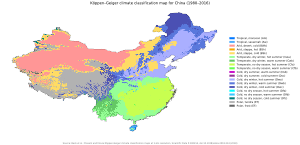
The Qinling–Huaihe Line (Chinese: 秦岭淮河线; pinyin: Qínlǐng Huáihé Xiàn) is a reference line used by geographers to distinguish between northern and southern China, corresponding roughly to the 33rd parallel.[1][2] Qinling refers to the Qin Mountains, and Huaihe refers to the Huai River.[3] Running from Qin Mountain in the west to Huai River in the east, it divides eastern China into northern and southern regions that differ from each other in climate, culture, lifestyle, and cuisine.[4]
Regions north of the Line tend to be temperate or continental, with snow being a regular feature in winter. Regions south of the Line tend to be subtropical or tropical. In general, the southern region is hotter, wetter, and much more hilly than the northern region.
History

The line has served as the border between northern and southern Chinese dynasties: between the Northern and Southern dynasties of c. 3th–6th century and between the Southern Song of c. 13th century and its northern neighbor Jin dynasty.
Historically, due to being the Cradle of Chinese Civilization, the North had been more developed than the South. That has changed over time and three of the four most developed Tier 1 cities in China are in the South. It was in the Ming dynasty that the economy of the South started to outpace the economy of the North.[1][5] The gross regional product (GRP) of provinces and counties below the line was equal to those above the line in 1960, but by 2019, the south's GRP had become 83% larger than the north's.[4]
In 1908, Chinese geographer Zhang Xiangwen defined northern China as anything above a line running along the Qinling in the west and the Huai River the east.[6] In the 1950s, when large social projects were common yet the country was poor, it was decided that subsidized district heating systems would only be installed north of the line.[6] Because the major source of heating came from coal-burning plants as of 2010, the north has historically suffered from heavier air pollution.[7] Nevertheless, a 2014 poll suggests that southerners also want central heating. Some places just south of the Qinling–Huaihe Line can become quite cold in the winter, making life difficult especially for those who cannot afford electrical heating at the market rate.[8][9]
Climate and geographical significance

The line is attributed with serving as a division line in the hydrology and climatology of China. It roughly coincides with:[10]
- the 800 mm (31 in) annual precipitation line (isohyet) of China; by extension, the division between China's humid and semi-humid areas and rice or wheat production areas;
- the 0 °C (32 °F) average January temperature (isotherm) line of China; by extension, China's subtropic zone;
- the division between the drainage basins of the Yangtze and Yellow Rivers.
See also
- Heihe–Tengchong Line, divides China in eastern and western halves
- Mason–Dixon line, North American counterpart
References
- ^ a b Shuangshuang, LI; Saini, YANG; Xianfeng, LIU (10 September 2015). "Spatiotemporal variability of extreme precipitation in north and south of the Qinling-Huaihe region and influencing factors during 1960-2013". The Chinese Journal of Geography. 34 (3): 354–363. Retrieved 25 May 2017.
- ^ Kemp, John (2014-05-22). "For 'dirty man of Asia,' Russian gas deal offers clean solution". The Japan Times Online. ISSN 0447-5763. Retrieved 2018-04-04.
- ^ Xingzhong, Liu. "Fungal diversity in China". www.mycolab.org.cn/. State Key Laboratory of Mycology. Retrieved 25 May 2017.
- ^ a b Harada, Issaku. "China's 'North-South divide' to worsen as COVID hits economy". Nikkei Asia. Retrieved 2021-06-06.
- ^ "Living Below China's Qinling-Huaihe Line Leaves Many Southerners in the Cold". www.journalism.hkbu.edu.hk. Hong Kong University. 30 August 2013. Retrieved 25 May 2017.
- ^ a b "China's unlikely divide over home heat". The National. Retrieved 2018-04-04.
- ^ Feng, Hao (2017-12-14). "Three-year cut to life expectancy from coal heating". Eco-Business. Retrieved 2018-04-04.
- ^ Huang, Zheping (10 November 2015). "Northern China's dilemma—if you want heat in the winter, it comes with toxic air pollution — Quartz". qz.com. Retrieved 2018-04-04.
- ^ hermesauto (2018-01-04). "Old central heating rule leaves old Shanghai neighbourhood shivering in winter". The Straits Times. Retrieved 2018-04-04.
- ^ S.S., Li; J.P., Yan; J, Wan (1 June 2012). "The characteristics of temperature change in Qinling Mountains". Scientia Geographica Sincia. 32 (7): 853–858.
